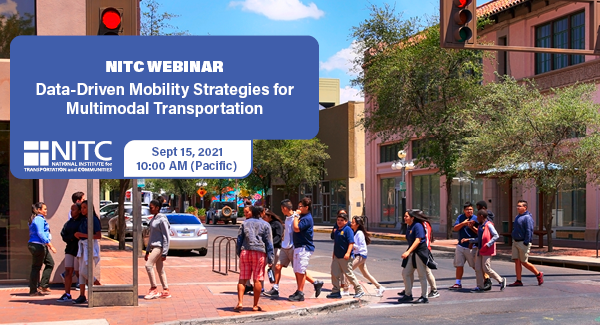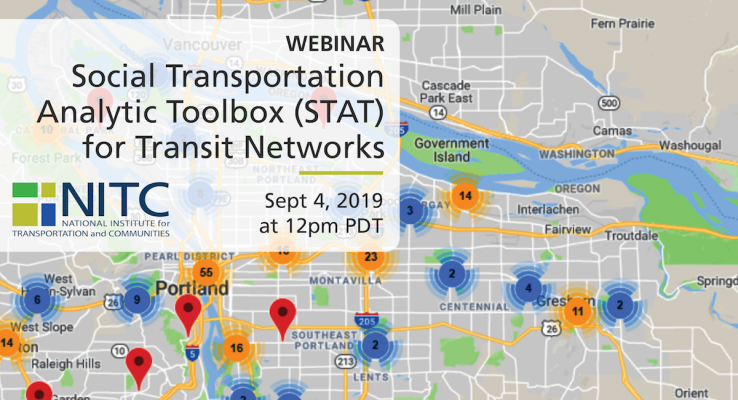The video begins at 0:10.
Summary: The declining rates of physical activity among children, particularly adolescent girls, are well-documented, yet there has been insufficient research into the attitudes about health behaviors, particularly active travel, of the children themselves. Tara's research explores attitudes about active transportation among children aged 4-17 years and examines how perceived ability, self-efficacy, and sensitivity to certain environments or facilities vary across gender and age of the children. She utilises data from the Family Activity Study, a multi-year longitudinal intervention study in Portland, Oregon, in which 490 children answered surveys regarding their attitudes, perceptions, and behaviors about traveling by walking, bicycling, or being in a car.
PRESENTATION ARCHIVE
OVERVIEW
Multimodal transportation systems (e.g., walking, cycling, automobile, public transit, etc.) are effective in increasing people’s travel flexibility, reducing congestion, and improving safety. Therefore, it is critical to understand what factors would affect people’s mode choices. With advanced technology, such as connected and automated vehicles, cities are now facing a transition from traditional urban planning to developing smart cities. To support multimodal transportation management, this study serves as a bridge to connect speed management strategies of conventional corridors to connected vehicle corridors.
The study consists of three main components. In the first component, the impact of speed management strategies along traditional corridors was evaluated. In the second component, the impacts of the specific speed management strategies, signal retiming and...
Read moreThe video begins at 0:49.
It has been nearly 25 years since non-motorized modes and non-motorized-specific built environment measures were first included in the regional travel demand models of metropolitan planning organizations (MPOs). Such modeling practices have evolved considerably as data collection and analysis methods improve, decisions-makers demand more policy-responsive tools, and walking and cycling grow in popularity. Many models now explicitly consider the unique characteristics of walking travel, separate from travel by bicycle. As MPOs look to enhance their models’ representations of pedestrian travel, the need to understand current and emerging practice is great.
This project presents a comprehensive review of the practice of representing walking in MPO travel models. A review of model documentation determined that – as of mid-2012 – 63% (30) of the 48 largest MPOs included non-motorized travel in their regional models, while 47% (14) of those also distinguished between walk and bicycle modes. The modeling frameworks, model structures, and variables used for pedestrian and non-motorized regional modeling are described and discussed. A survey of MPO staff members revealed barriers to modeling non-motorized travel, including insufficient travel survey records, but also innovations being implemented, including smaller zones and non-motorized network assignment. Finally, best practices in...
Read moreTransportation mode choice is often expressed in terms of models which assume rational choice; psychological case studies of mode adoption are comparatively rare. We present findings from a study of the psychology of adoption for sustainable transportation modes such as bicycles, car sharing, and mass transit. Case studies were conducted with current and former participants in PSU’s ‘Passport Plus’ transit pass program, as well as a longitudinal cohort study of first-time winter bicycle commuters. Composite sequence analysis was used to construct a theory of the adoption process for these modes. Our findings suggest that mode evaluation is cognitively distinct from mode selection and has different information requirements. We conclude that public and private organizations could improve the adoption rate for these modes by tailoring their communication strategies to match the commuter’s stage of adoption.
View slides
The video begins at 9:01.
PRESENTATION ARCHIVE
Miss the webinar or want a look back?
OVERVIEW
This webinar will present an open-source socio-transportation analytic toolbox (STAT) for public transit system planning. This webinar will consist of a demonstration of the STAT toolbox, for the primary purpose of getting feedback from transit agencies on the tool's usefulness. We are especially interested in hearing about any improvements that would aid transit agencies in implementing it.
The STAT toolbox was created in an effort to integrate social media and general transit feed specification (GTFS) data for transit agencies, to aid in evaluating and enhancing the performance of public transit systems. The toolbox enables the integration, analysis, and visualization of two major new open transportation data sources—social media and GTFS data—to support transit decision making. In this webinar, we will introduce how we...
Read moreThe video begins at 1:44.
Oliver Smith (USP PhD) - Peak of the day or the daily grind? Commuting and subjective well-being
To understand the impact of daily travel on personal and societal well-being, measurement techniques that go beyond satisfaction-based measures of travel are used. Such metrics are increasingly important for evaluating transportation and land-use policies. This study examines commute well-being, a multi-item measure of how one feels about the commute to work, and its influences using data from a web-based survey that was distributed to Portland, Oregon, U.S.A. workers. Valid surveys (n=828) were compiled from three roughly equally sized groups based on mode: bike, transit and car users. Average distances between work and home varied significantly among the three groups. Descriptive results show that commute well-being varies widely across the sample. Those who bike to work have significantly higher commute well-being than transit and car commuters. A multiple linear regression model shows that along with travel mode, traffic congestion, travel time, income, health, job satisfaction and residential satisfaction also play important individual roles in shaping commute well-being. While more analysis is needed, these results support findings in previous research that commuting by bike enhances well-being while congestion detracts from well-being. Implications...
Read more

